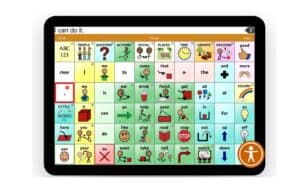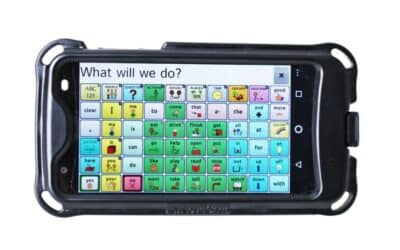Children with a diagnosis of Down syndrome may face challenges in speech and language development that can interfere with their ability to understand and use language and produce clear speech. In this article, we will explore how Augmentative and Alternative Communication (AAC) can help children with a diagnosis of Down syndrome who may face these challenges. We’ll share rationale for using AAC, provide examples of various AAC types, discuss evaluation and funding AAC, and describe how AAC usage evolves with the individual’s needs and skills.

What is AAC?
Augmentative and Alternative Communication (AAC) encompasses a range of communication methods, strategies and tools designed to supplement or replace spoken language, It is used for those who have difficulties producing clear speech and understanding and using language to communicate. Children with a diagnosis of Down syndrome may benefit from the use of AAC strategies, methods, systems, and devices.
Rationale for Using of AAC
AAC acts as a key enabler for children with Down syndrome, opening doors to more active engagement in the world through better communication. It effectively tackles a range of speech, language, and communication challenges, providing tailored support to each child’s individual strengths and needs. Here’s a closer look at the specific benefits AAC offers.
Overcoming Communication Barriers with AAC
- Enhancing Communication: AAC provides children with a way to more fully engage with their family, school, and community.
- Addressing Speech and Language Delays: AAC can be vital for children experiencing delays in speech and language development. It offers an alternative method that supports their communication growth.
- Articulation Issues: For children facing articulation difficulties, AAC can supplement or replace unclear speech, ensuring their messages are understood.
- Auditory Processing Challenges: AAC systems help children who struggle with auditory processing by providing visual and tactile cues to support their understanding and expression.
Development and Social Inclusion with AAC
- Enhancing Language Skills: AAC aids in developing language skills. It provides a visual and concrete way to practice and use language, helping children expand their vocabulary and improve sentence structure.
- Social Interaction and Inclusion: With AAC, children with Down syndrome can participate more fully in social and educational, and work settings.
- Cognitive Development: AAC use stimulates cognitive development, enhancing problem-solving, symbol recognition, and memory skills.
- Reducing Frustration and Educational Benefits: AAC lessens frustration related to communication difficulties and aids in classroom participation, curriculum access, and peer interaction.
- Empowerment and Independence, Family Communication: AAC empowers children, fostering confidence and independence. It also improves communication with family members, strengthening relationships and easing daily interactions.
Different Types of AAC
AAC can be divided into two main categories unaided AAC and aided AAC.

Unaided AAC
Unaided AAC refers to communication methods that do not require the use of any external aids. We all use unaided AAC every day. A few examples are highlighted below.
- Sign Language: This is the most well-known form of unaided AAC. Sign language uses manual communication and body language to convey meaning. It involves movements of the hands, arms, face, and body to express words and concepts.
- Gestures: Gestures are natural movements or positions of the hand, arm, head, face or body that are used to convey ideas or meanings. These can be simple movements like nodding for “yes” or more complex series of gestures representing different ideas.
- Facial Expressions: Facial expressions are a powerful form of communication and can convey a wide range of emotions, messages, and reactions. Smiling, frowning, raising eyebrows, and other facial movements are all forms of communication.
- Body Language: Body posture and movements can communicate feelings and intentions. For example, turning towards someone can indicate interest, while crossing arms might show disengagement or discomfort.
Aided AAC
Low-Tech AAC
These are simple, non-electronic communication tools.

- Individual pictures or symbols: Photographs, pictures, or symbols use individually or in a series to convey a message.
- Picture boards or books: Boards or books with pictures or symbols that the user can indicate messages by point or other means to communicate.
- Communication boards: Organized boards with pictures, symbols, letters, and/or words that can be used to form messages of various lengths and complexity.
- Paper-based tools: Anything from pen and paper for writing messages to custom-made communication charts.
Mid-Tech AAC

- This refers to AAC devices and tools that are more sophisticated than basic, non-electronic options but less complex than high-tech AAC systems. These systems often provide a balance between simplicity and functionality, making them suitable for individuals who need more than low-tech options but may find high-tech devices too complex or costly.
- Recorded Speech Devices: These devices can play pre-recorded messages. Users press buttons or switches that correspond to specific words, phrases or sentences.
- Simple Voice Output Communication Aids: Unlike more advanced speech-generating devices, these aids typically have a limited vocabulary and simpler interface.
- Electronic Picture Boards: These are electronic versions of traditional picture boards, where pressing a picture or symbol produces a corresponding spoken word or sound.
- Adapted Digital Recorders: Users can play back messages on these simple digital recorders adapted for AAC use, allowing users to express an idea.
- Dynamic Display Devices (Simpler Versions): Unlike complex dynamic display devices, these have a more limited range of options and simpler navigation, suitable for individuals who need a straightforward interface.

High-Tech AAC
- These involve sophisticated electronic devices or computer-based tools. Examples include:
- Speech-generating devices (SGDs): When a symbol, letter, or word is selected, speech is generated. These devices may be dynamic display meaning that activation of one cell can give access to other related vocabulary. They can range from devices with a small vocabulary to complex systems with extensive vocabulary options. Speech generating devices can be dedicated only to communication or non-dedicated or multifunctional such as AAC software on an iPad.
- Dedicated AAC devices: These are devices specifically designed for AAC and AAC only. They often have dynamic display and robust customized features.
- Software applications: AAC application software loaded onto a tablet computer or smartphones that functions as a speech generating device with rich vocabulary access and dynamic display features.
- Speech-generating devices (SGDs): When a symbol, letter, or word is selected, speech is generated. These devices may be dynamic display meaning that activation of one cell can give access to other related vocabulary. They can range from devices with a small vocabulary to complex systems with extensive vocabulary options. Speech generating devices can be dedicated only to communication or non-dedicated or multifunctional such as AAC software on an iPad.
How are AAC Needs Evaluated and Funded?
AAC Evaluation
A speech-language pathologist or a diagnostic team, including a speech-language pathologist, conducts a comprehensive assessment to evaluate a child’s AAC needs and strengths. This process takes into account the child’s understanding of language, use of language, communication needs and environments, current developmental level, vision and hearing status, motor skills, and more. The assessment often includes:
- A review of the child’s medical, speech and language, developmental, and social history.
- Review of hearing and vision status.
- An assessment of the child’s current communication skills.
- Observation and or review of the child’s communication in different settings.
- Assessment of the child’s ability to indicate or act on a system or device using touch, scanning, eye gaze or other mode, and seating needs.
- The evaluator or evaluating team usually arranges and supports the completion of a trial period for the selected mid-high technology option or options.
AAC Funding
AAC systems and devices range in cost up to several thousand dollars and funding can be a significant consideration. Here are a few funding options.
- Insurance: Insurance plans may cover the cost of AAC systems. Often there are restrictions about how many devices it will cover in a lifetime.
- Medicaid: Medicaid may cover the cost of AAC systems for eligible individuals.
- School districts: Schools may provide AAC systems and devices for students who require them. These systems and devices are intended for school as well as home use.
- Charitable resources: Agencies may cover the cost of an AAC system. This could include a device or a new or used tablet computer via an application process and grants.
- Private Funding: Family members or other individuals can purchase AAC systems directly.

AAC Use
AAC use usually changes over time as the child’s communication needs and skills evolve and their communication environments broaden. For example, a child may use more than one type of AAC at a time in their development, such as sign language and a picture communication board. Similarly, they may use different types of AAC at different times in their life.
As a child becomes more proficient with a specific AAC system, they may require more advanced or customized systems to meet their needs. The communication setting can also influence the type of AAC system that is most effective. For example, a child may require a different AAC system in a noisy or busy environment than they would in a quiet environment.
FAQs
- What is the best type of AAC system for children with Down syndrome?
- The best type of AAC system depends on the child’s individual needs and development. A comprehensive assessment can determine the most appropriate system. Parent input is vital to this process.
- How long does it take for a child to become proficient in using AAC?
- Developing proficiency in using AAC is an ongoing process. The child’s individual needs, rate of learning, exposure to consistent quality practice, along with the type or types of system used influence the amount of time it takes for them to become proficient. As a child gains proficiency, their use of AAC will expand and become more sophisticated. Ongoing training and support for the child as well as for their family, caregivers, and educators is essential for the child’s maximum progress and development.
- Can AAC hinder the development of verbal speech in children with Down syndrome?
- No, AAC does not hinder the development of speech. In fact, research shows it can enhance the development of communication skills, which may lead to improved speech.
- What role do parents and caregivers play in the use of AAC with children with Down syndrome?
- Parents and caregivers play a critical role in the use of AAC by embracing, modeling, implementing, and supporting AAC on a daily basis. Parent involvement it key in the AAC decision making process, receive training and updates to support to ensure effective use of the system in the home environment, and routinely collaborate with the professionals on their child’s team.
- Can AAC be used by adults with Down syndrome?
- Yes! Adults with a diagnosis of Down syndrome who experience communication difficulties can use AAC. The evaluation process would be similar to that described above.
Additional Resources
- Say What? Augmentative and Alternative Communication – Down Syndrome Resource Foundation (dsrf.org)
- AAC – Down Syndrome Resource Foundation (dsrf.org)
- Low Tech Communication Board Library in English and Spanish (padlet.com)
- (1) Video | Facebook
- Augmentative and Alternative Communication (AAC) (asha.org)
- ISAAC – Home (isaac-online.org)
- implementation ideas : PrAACtical AAC
Summary/Conclusion
Augmentative and alternative communication (AAC) opens up a world of communication possibilities for children experiencing difficulty communicating through spoken language. It can be highly beneficial for children with a diagnosis of Down syndrome who require it. AAC can empower a child with an ability to expand their understanding of language as well as effectively express their needs, wants, feelings, and ideas. AAC can make a remarkable difference in the life of a child!




0 Comments